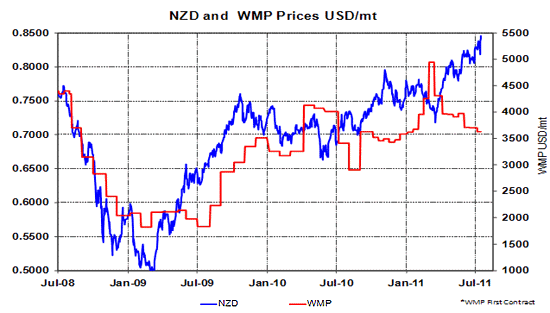
 By Roger J Kerr
By Roger J Kerr
The NZ dollar continues its spectacular rise as our economic performance and outlook just looks so much better than alternatives in the eyes of foreign investors and currency speculators.
Last week’s GDP growth result of a +0.8% increase in the March quarter confirming that the export boom from super high commodity prices has been underway for nine months already, however the economic expansion has largely gone on below the radar of most.
The NZ dollar has strengthened again on the back of the strong growth numbers.
In particular, the Kiwi dollar has jumped another cent higher against the AUD, from 0.7850 to 0.7950. Despite the resources boom, the overall Australian economy is starting to struggle in the face of their high AUD value (non-mining exports) and weak retail spending.
The latest talk in Australian financial markets is that the Reserve Bank of Australia’s next change with official interest rates may well be downwards.
The AUD/USD exchange rate has been trading up and down the 1.0500 to 1.0800 range, however luck appears to be running out for the lucky country and global investors now seem to be reluctant buyers of AUD’s at the higher levels. The AUD/USD exchange rate also tracks the JPY/USD rate closely.
The Japanese Yen has strengthened to below 80.00 against the USD on investors holding off from buying USD’s until the US Government debt ceiling problem in resolved. The foreign exchange markets are very wary of Bank of Japan intervention, selling the Yen and sending the rate higher to 85.00 and 90.00. If this did occur, the AUD would follow and be sold below 1.0000 to the USD.
The NZD has made impressive gains against all the currencies, with all cross-rates increasing over recent weeks. Such across-the-board gains tells us that this is specific and separate NZD strength.
The buyers of NZD’s continue to be mostly Asian-sourced, sovereign wealth funds and currency momentum traders.
They like the positive NZ economic story from our agriculture export prices being at 30-year highs. Last week’s extraordinary GDP numbers confirming their perhaps superior understanding of what drives the NZ economy compared to local mainstream economists who ended up forecasting a 0.4% GDP increase, however only a few months ago most of whom were projecting a negative number.
The foreign investor confidence in the NZ economy and currency is largely based on the price of our major export, wholemilk powder (“WMP”). The globally traded WMP prices were recording sharp gains up until March of this year.
However, over recent months, as evidenced in the fortnightly Fonterra GDT on-line auctions, the prices have corrected downwards rather dramatically. In their milksolids payout forecast to dairy farmers for the next year, Fonterra appears confidence that WMP prices will hold up at the USD3,600 per tonne levels. However, there is no guarantee about that and all commodity prices do not have the same invincibility about them that they enjoyed a few months back.
Global growth has been revised downwards and eventually US interest rates will increase, both of which are negative for commodity prices.
If the NZ dollar has one vulnerability to a sell-off it would have to be WMP prices continuing to slide downwards. Many of the Asian investors who have bought into the Kiwi dollar have done so on the back of the positive dairy story. If falling WMP prices start to undermine the original rationale for buying and holding the Kiwi, the currency’s attractiveness will rapidly wane.
The chart below demonstrates just how far the Kiwi’s appreciation in recent months has diverged from falling WMP prices (in USD’s). The historical correlation is reasonably robust, therefore either WMP rises again or the NZD/USD rate falls.

In the short-term, a resolution of the US debt ceiling well before the 2 August deadline date should allow for a recovery in the USD value against the EUR and JPY. The soft patch in US economic data over recent months has also been partially caused by US corporations waiting-off on investment decisions until they see that their own Government can get their financial house in order. Compromise is required from both political sides to end the current impasse and the pressure coming from the credit rating agencies and Ben Bernanke at the Federal Reserve.
A USD exchange rate value against the Euro travelling below $1.4000 (currently $1.4100) towards $1.3500 should bring the NZD back from 0.8500.
--------------------
* Roger J Kerr runs Asia Pacific Risk Management. He specialises in fixed interest securities and is a commentator on economics and markets. More commentary and useful information on fixed interest investing can be found at rogeradvice.com
No chart with that title exists.

We welcome your comments below. If you are not already registered, please register to comment.
Remember we welcome robust, respectful and insightful debate. We don't welcome abusive or defamatory comments and will de-register those repeatedly making such comments. Our current comment policy is here.